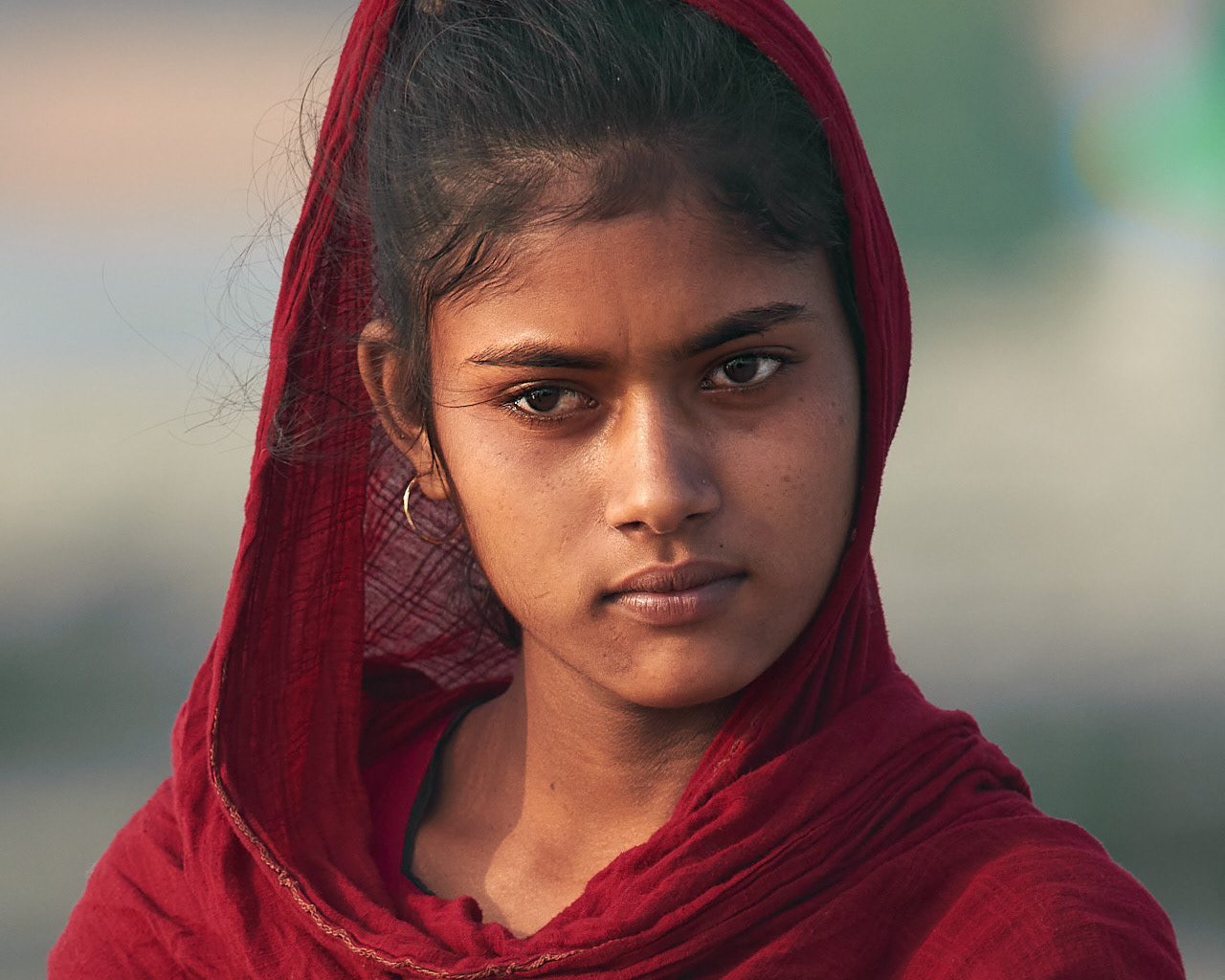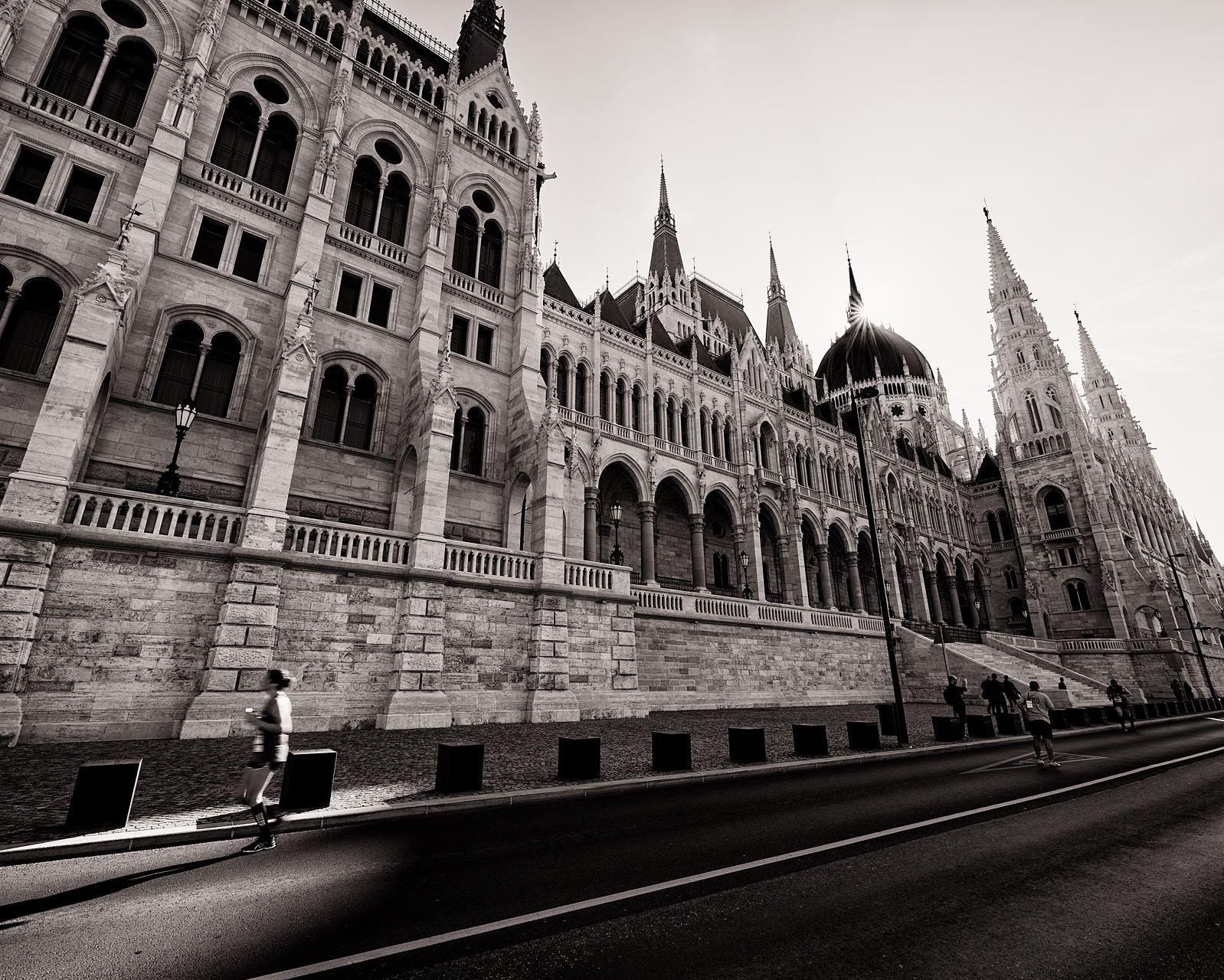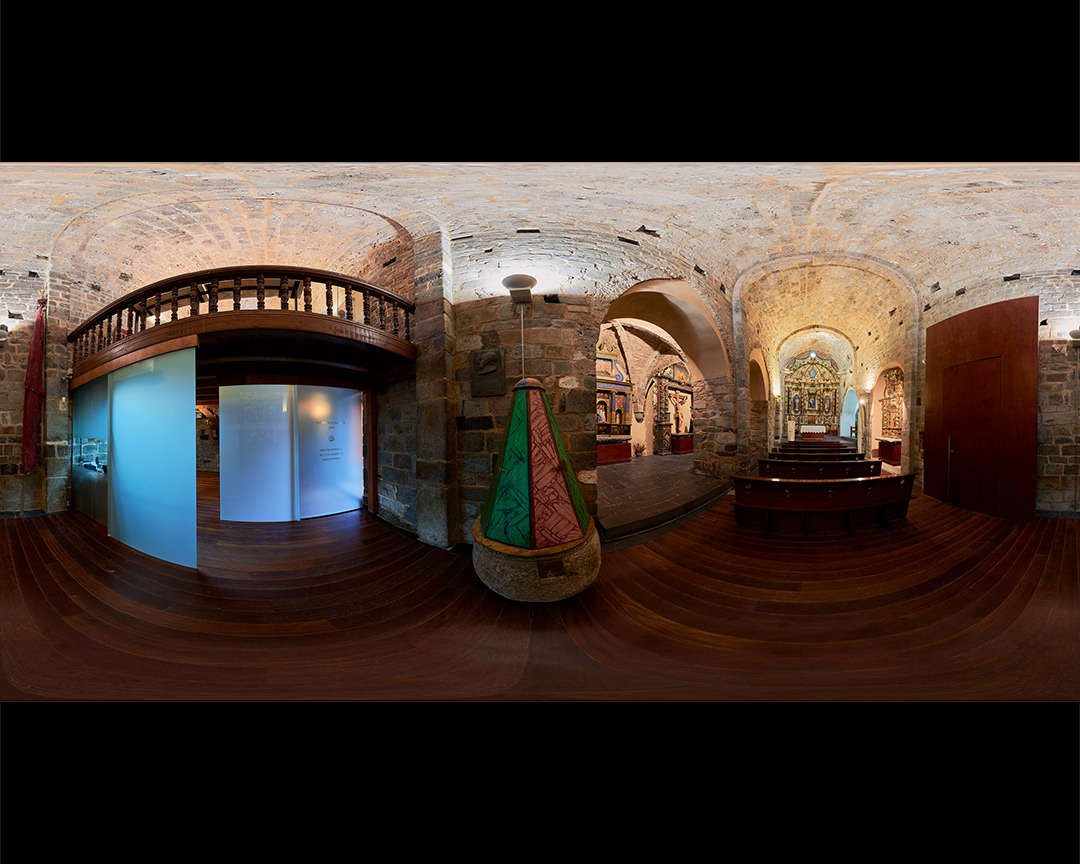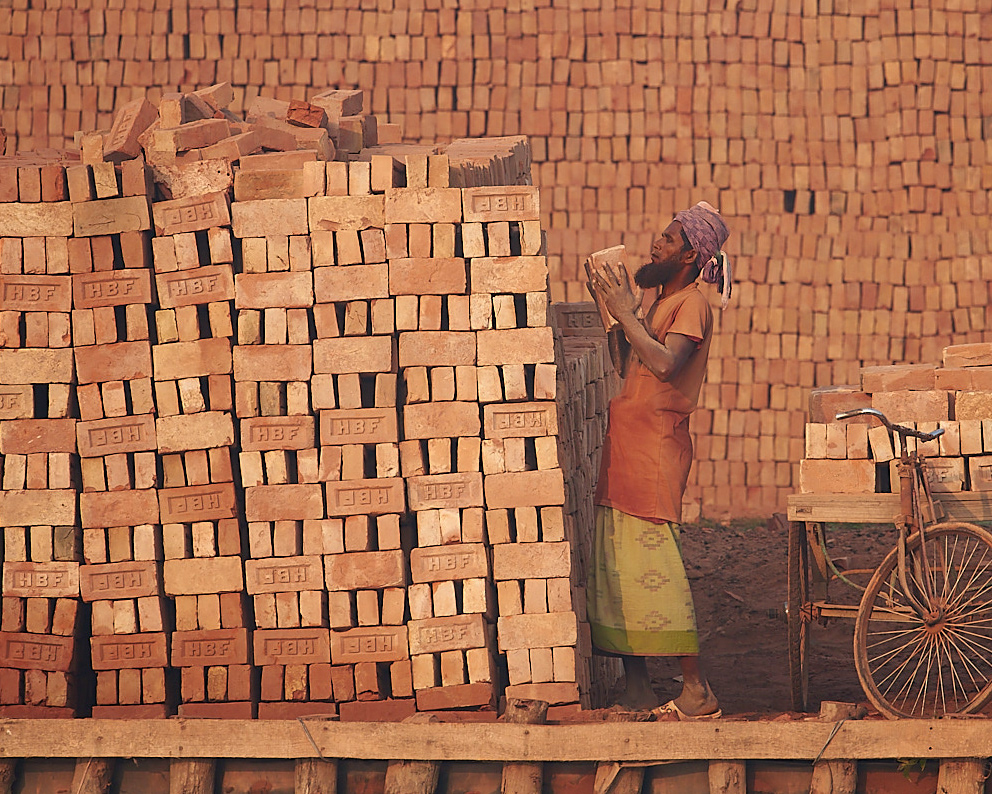Kalta Minor and Muhammad Amin Khan Madrasah. Kalta Minor which means “short minaret” is probably the most iconic symbol of Khiva, Uzbekistan. The minaret was built by Mohammed Amin Khan in 1851 who wanted to build a minaret of 70 meters so that he could see all the way to rival khanate Bukhara 400 km away. Construction stopped when the khan was killed in 1855 and the minaret was left unfinished at a height of only 26 meters. Muhammad Amin Khan Madrasah hosts one of the best hotels inside the walls of the Ichan Kala (“inner town”), where rooms used to be students’ cells in the madrasa (a religious university). Captured with Nikon D800, 14-24 mm f/2.8 lens @ 14 mm, 1/800 sec., f/5.6, ISO 100.
Royal yurt inside the courtyard of Arz-Khovli in the Tosh-Hovli Palace, which the no-longer-nomadic khans still liked to use. Tosh-Hovli Palace, summer residence of Khivan Khans, was built in the eastern part of the Ichan Kala (“inner city”). There are three yards within the complex, one for receiving guests (Arz-Khovli), one for entertainment (Ishrat-Khovli), and one for the harem all joined by labyrinths of corridors. Captured with Nikon D800, 14-24 mm f/2.8 lens @ 18 mm, 1/500 sec., f/5.6, ISO 100.
Tosh-Hovli Palace which means "Stone House" contains Khiva’s most sumptuous interior decoration, dense with blue ceramic tiles, carved wooden pillars and elaborate ghanch (mural paintings). It’s said to have more than 150 rooms off nine courtyards, with high ceilings designed to catch the slightest desert breeze. Captured with Nikon D800, 14-24 mm f/2.8 lens @ 14 mm, 1/60 sec., f/5, ISO 100.
Removing shoes, the bridal entourage entered the interior of Pahlavon Mahmud Mausoleum in Khiva, Uzbekistan. Bridal couples came to the mausoleum on their wedding day, the groom drew water from the courtyard well and offered it to his bride in the hope of ensuring many children. Mullah was intoning prayers in Arabic, while the bridal couple offered fresh bread, money and borsok (popular fried dough bed classically dipped in jams, honey or butter). Captured with Nikon D800, 14-24 mm f/2.8 lens @ 24 mm, 1/40 sec., f/2.8, ISO 800.
Islom-Hoja Minaret and Pakhlavan Makhmoud Mausoleum’s dome at sunset. The Islom-Hoja Minaret at Khiva is the tallest in Uzbekistan. The beautiful Persian-style chamber under the turquoise dome of the Pakhlavan Makhmoud Mausoleum holds the tomb of Mohammed Rakhim Khan. Captured with Nikon D800, 300 mm f/4 PF lens @ 1/320 sec., f/4, ISO 200.
Kalta Minor from Kuhna Ark fortress watchtower at sunset. Khiva rulers’ own fortress and residence, first built in the 12th century by one Ok Shaykh Bobo, then expanded by the khans in the 17th century. The khans’ harem, mint, stables, arsenal, barracks, mosque and jail were all here. Captured with Nikon D800, 135 mm f/2.8 lens @ 1/320 sec., f/5.6, ISO 100.
It's well worth to climb up to the watchtower of Kuhna Ark fortress to enjoy the extraordinary city’s views, especially at sunset. The outer town of Khiva is called Dichan Kala and is protected by a wall with 11 gates. The inner town or Ichan Kala is surrounded by brick walls originally laid in the 10th century. Most of the historical monuments are within Ichan Kala which was where all the high officials, clergy, and rich merchants used to live. Captured with Nikon D800, 135 mm f/2.8 lens @ 1/320 sec., f/4, ISO 250.
Kuhna Ark fortress and Kalta Minor Minaret at night from Terrassa Cafe. Khiva was the former capital of Khwarezmia and the Khanate of Khiva and was the first place in Uzbekistan to be made a UNESCO World Heritage Site in 1990. For sure one of my favourite ancient Silk Road cities in Central Asia. Captured with Nikon D800, 24-70 mm f/2.8 lens @ 42 mm, 1/15 sec., f/2.8, ISO 800.
Man riding a bicycle beside Kalom Mosque at sunrise. Bukhara with more than 140 architectural monuments is a "town museum" dating back to the Middle Ages. The city consists of narrow streets, green parks and gardens, historical and architectural monuments belong to the different epochs, but locate very close to each other. Captured with Nikon D800, 24-70 mm f/2.8 lens @ 60 mm, 1/500 sec., f/10, ISO 200.
The religious complex Po-i-Kalan, which means "The Foot of the Great”, at sunrise. It is the central Bukhara tourist attraction located in the main Registan Square. Po-i-Kalan, consists of three structures built in the 12th - 16th centuries: Kalan Mosque (right), Mir-i Arab Madrasah (left) and Kalan Minaret, also known as the Tower of Death because for centuries criminals were executed by being thrown from the top. Captured with Nikon D800, 14-24 mm f/2.8 lens @ 14 mm, 1/100 sec., f/8 ISO 100.
Bolo Haouz Mosque, built in 1712, is inscribed in the UNESCO World Heritage Site list along with the other parts of the historic city of Bukhara. It served as a Friday mosque during the time when the emir was being subjugated under the Bolshevik Russian rule in 1920s. Thin columns made of painted woods were added to the frontal part of the iwan (entrance) in 1917, additionally supporting the bulged roof of summer prayer room. The columns are decorated with coloured muqarnas (stalactite cornices). Captured with Nikon D800, 24-70 mm f/2.8 lens @ 31 mm, 1/250 sec., f/8, ISO 100.
Abdul Aziz Khan Madrasah, built in 1652, has a special place among the monuments of Bukhara in the richness of artistic decoration. The external decoration predominates with a characteristic mosaic motif of flowering shrub in the vase. Captured with Nikon D800, 135 mm f/2.8 lens @ 1/160 sec., f/5.6, ISO 125.
The main facade of Abdul Aziz Khan Madrasah has a central pishtak (portal frame that surrounds the high portal arch) with an unusual 5/8 octagon iwan (in general the hall is rectangular) in this madrasa. The upper end of the iwan is an exceptional muqarnas. Captured with Nikon D800, 135 mm f/2.8 lens @ 1/160sec., f/5.6, ISO 125.
Toki-Zargaron is the largest trading dome of Bukhara. It is the most northern dome and it is located fast beside the Po-i-Kalan religious complex. The name Zargaron is connected with the word “zargar” which can be translated as “goldsmith”. Once there located 36 jeweller's workshop-shops selling various jewelries. In addition, Toki-Zargaron was the first among the trading domes of Bukhara. Captured with Nikon D800, 135 mm f/2.8 lens @ 1/160 sec., f/5.6, ISO 125.
Abdul Aziz Khan Madrasah was the last monumental building of this scale in the capital of the Bukhara Khanate. After the death of Abdulaziz Khan followed a period of decline of Bukhara. Never over Bukhara was not rich enough and stable to carry out construction of such luxury buildings. Captured with Nikon D800, 135 mm f/2.8 lens @ 1/250 sec., f/4, ISO 100.
When Kalon Minaret was built by the Karakhanid ruler Arslan Khan in 1127, it was probably the tallest building in Central Asia (Kalon means “great” in Tajik). It’s an incredible piece of work, 47 m tall with 10 m deep foundations, including reeds stacked underneath in an early form of earthquake-proofing, and has stood for almost nine centuries. Chinggis (Genghis) Khan was so dumbfounded by it that he ordered it spared while his troops ransacked the rest of the city. Captured with Nikon D800, 14-24 mm f/2.8 lens @ 15 mm, 1/40 sec., f/5, ISO 640.
Without any doubt the golden ceiling of Tilla-Kari (Gold-Covered) Madrasah in Samarkand is the most famous of Uzbekistan. This delicate ceiling, oozing gold leaf, is flat but its tapered design makes it look domed from the inside. The result is breathtaking. Captured with Nikon D800, 14-24 mm f/2.8 lens @ 18 mm, 1/20 sec., f/4, ISO 500.
These examples of ornamental tile jewels in Samarkand show patterns of interconnections, alternations between straight-line and floral motifs, and the embedding of Arabic letterings. The development of the unbelievable phantasy of such tile decorations is also based on religious demands. The founder of Islam did not allow the depiction of humans, animals and even plants. This inspired the imagination of artists and architects in unexpected ways and led to the highest achievements of the art of writing and building decoration. Several shots captured with Nikon D800 with different lens and settings, and composed with Photoshop CC.
Sherdor Madrasah through the stone lattice work window. This madrasa is one of the three monumental religious buildings of Registan Square, in the ancient centre of the city of Samarkand and it is one of the main sights of the city. Captured with Nikon D800, 135 mm f/2.8 lens @ 1/250s sec., f/4, ISO 100.
Siyob Bazaar, also called Siab Bazaar, located next to the Bibi-Khanym Mosque, is a dekhkan (agricultural) market in Samarkand where you will mainly find vegetables and fruits grown in Uzbekistan, as well as local hand-made products. Trading rows are conditionally divided according to types of goods. Local sellers say that Siab dried fruits, sweets and nuts are so tasty that make residents of the capital city travel there for their portion. It is also possible to meet huge number and kinds of spices at the bazaar, even the rare ones. Captured with Nikon D800, 135 mm f/2.8 lens @ 1/200 sec., f/4, ISO 800.
Shah-i-Zinda in Samarkand is one of the oldest and longest-running examples of a continually constructed historic site in the world. It was established with a single religious monument over 1,000 years ago. Various temples, mausoleums, and buildings were continually added throughout the ensuing centuries, from approximately the 11th century to the 19th. The result is a fascinating cross-reference of various architectural styles, methods, and decorative craftsmanship as they have changed throughout a millennium of work. Captured with Nikon D800, 135 mm f/2.8 lens @ 1/500 sec., f/4, ISO 100.
The name Shah-i-Zinda (meaning "The living king") is connected with the legend that Kusam ibn Abbas, a cousin of the prophet Muhammad, is buried here. He came to Samarkand with the Arab invasion in the 7th century to preach Islam. Popular legends speak that he was beheaded for his faith, but he didn't die, took his head and went into the deep well (Garden of Paradise), where he's still living now. Captured with Nikon D800, 135 mm f/2.8 lens @ 1/160 sec., f/4, ISO 100.
Bibi-Khanym Mosque at twilight. This mosque is one of the most important monuments of Samarkand. In the 15th century it was one of the largest and most magnificent mosques in the Islamic world. By the mid-20th century only a grandiose ruin of it still survived, but major parts of the mosque were restored during the Soviet period. Handheld panorama made from 8 vertical shots, stitched with Photoshop CC. Captured with Nikon D800, 24-70 mm f/2.8 lens @ 24 mm, 1/50 sec., f/2.8, ISO 800.
Sher-Dor Madrasah in Samarkand's Registan Square at night lighted in preparation of the International Music Festival Sharq Taronalari ("Melodies of Orient”), one of the biggest festivals in Central Asia. The tiger mosaics with a rising sun on their back, on the facade of Sher-Dor Madrasah, are very interesting in that they flout the ban in Islam of the depiction of living beings on religious buildings, especially as they represent the more ancient Persian Mithraic religious motifs. Madrasah in 2001 entered the UNESCO World Heritage List. Handheld shot captured with Nikon D800, 135 mm f/2.8 lens @ 1/50 sec., f/2.8, ISO 2000.
A man praying in Tillya Sheikh Mosque. The Khast-Imam complex is the top Tashkent historic site and Islamic center, and a place for main prayers of the two major Muslim holidays in Uzbekistan, Ramadan Khait and Kurban Khait, celebrated each year according to the lunar calendar. Kurban Khait (Eid al-Adha) marks the end of the Hajj (pilgrimage to Mecca) an it is celebrated 70 days after the end of another major holiday - Ramadan Khait. Captured with Nikon D800, 24-70 mm f/2.8 lens @ 70 mm, 1/20 sec., f/5.6, ISO 100.
An interesting place to visit in Tashkent, Uzbekistan, is the Metro which was the first underground transportation system built in Central Asia. It is a masterpiece of decorated platforms, glazed columns, and shimmering tunnels. Before July of 2018, photography was prohibited inside the metro stations because of the military sensitivity of its second role as a nuclear bomb shelter. Now it is no longer considered military installations and commuters can capture the artworks on camera. Captured with Nikon D800, 14-24 mm f/2.8 lens @ 24 mm, 1/8 sec., f/2.8, ISO 160.
A train leaving Kosmonavtlar station in the Metro of Tashkent, Uzbekistan, in honour of the cosmonauts of the Soviet Union. The stop is famous for its dreamlike portraits of cosmonauts like Valentina Tereshkova, the first woman to go to space. The ceramic wall panels fade from blue to black in imitation of Earth’s atmosphere. Captured with Nikon D800, 14-24 mm f/2.8 lens @ 14 mm, 0.1 sec., f/2.8, ISO 400.
Mustaqilliq Maidoni (“Independence Square”) in Tashkent is the main square of the Uzbekistan, despite it looks more like a large park and it is packed with monuments and fountains. The entrance is framed by the Arch of Independence with the sculptural images of silvered storks on top. Captured with Nikon D800, 24-70 mm f/2.8 lens @ 52 mm, 1/200 sec., f/5.6, ISO 100.
The gorgeous Dvorets Mezhdunarodnykh Forumov (Uzbekistan Palace of International Forums) is the most expensive building constructed in post-independence Uzbekistan. The Palace stands on Amir Timur Square in the very centre of Tashkent and it is decorated with marble from the Greek Island of Thasos and with chandeliers made of hundreds of thousands of Swarovski crystals. Captured with Nikon D800, 24-70 mm f/2.8 lens @ 32 mm, 1/320 sec., f/4 ISO 100.
A summer’s night circus performance in Mustafa Kemal Atatürk Street, Tashkent. It was an incredible exhibition of different traditions of Central Asian people, like darboz (Rope-walkers), acrobatics and kettlebell juggling. On the territory of Uzbekistan this kind of circus performances are held in the bazaars or large squares. In the past no holiday was celebrated without an equilibrist show. Captured with Nikon D800, 24-70 mm f/2.8 lens @ 58 mm, 1/25 sec., f/2.8, ISO 2000.











